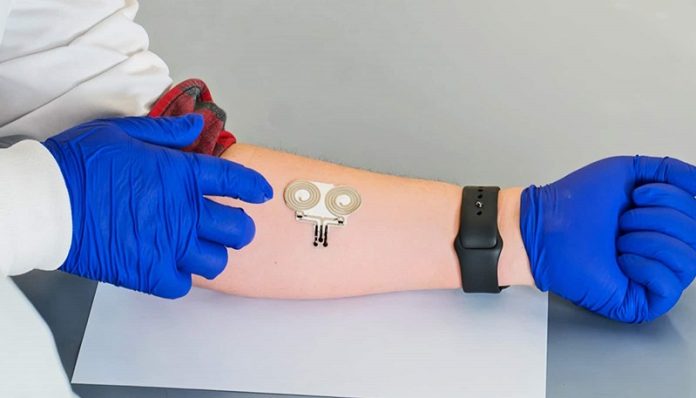
Researchers have made a significant breakthrough in the development of an on-skin bioelectronic wearable sensor: the addition of wireless charging—without batteries—through a magnetic connection.
The team’s innovation, an important component to its existing ultrasoft, breathable, and stretchable material, provides the foundation for gathering precise vital sign measurements like blood pressure, electrical heart activity, and skin hydration.
The discovery could one day lead to early detection and timely interventions for chronic diseases such as heart disease, cancer, and diabetes.
“A watch is a hard surface, so it’s not as effective as our material in providing accurate vital sign tracking,” says Zheng Yan, an associate professor in the University of Missouri’s College of Engineering, whose lab specializes in soft bioelectronics.
“Our porous, soft material acts as an electrical conductor, so it can maintain a stable electrical current during movement.
This is a significant step forward toward our overall goal to help improve the long-term biocompatibility and the long-lasting accuracy of wearable bioelectronics.”
The team’s end goal is to provide people with a convenient, comprehensive health picture through long-term self-health monitoring, and the capability to share that information wirelessly with a person’s health care provider.
And now, after years of research, Yan has overcome his biggest challenge to date—creating an accurate, wireless connection.
“If we can make affordable, customized electronics and equip our bodies with these devices, we can take proactive actions at the early stages of some diseased conditions and dramatically change and reshape our future,” says Yan.
The team plans to one day enhance the wearable sensor’s capabilities to track blood pressure and electrical activity in the heart.
While Yan’s material has significant on-skin capabilities, he and his team are also exploring the possibilities of integrating it with implanted devices such as a pacemaker.
“If a device made from our soft material can be put directly on the surface of the heart, we can get a more reliable and timelier signal, leading to early detection of this health issue,” Yan says.
Because the implanted material does not require Bluetooth technology and is battery free, it has advantages over existing technology, allowing for safe and effective use in medical applications.
The work builds on the team’s existing proof of concept, as demonstrated by their previous work, including a heart monitor currently under development.
The study appears in Nature Nanotechnology.



